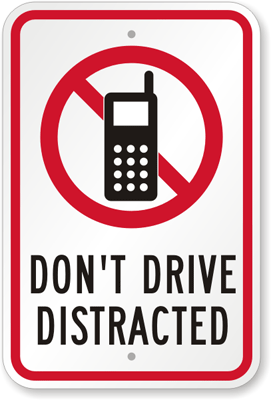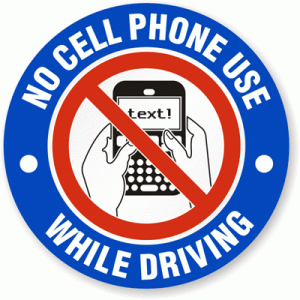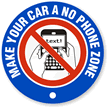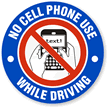This car “safety feature” actually puts you in more danger
Car manufacturers are introducing voice-to-text systems enabling drivers to hear and to reply to texts and emails while keeping their eyes on the road. While these systems may seem safe, an American Automobile Association (AAA) study reveals that they are actually more distracting than hands-free phones, hand-held phones, or listening to the radio or audiobooks.
Why is voice-to-text technology more distracting?

Signs like these serve as a reminder on the road. View this sign here.
Remember that blog post we wrote about the hilarious mistranslations by the Word Lens app? The repeated poor performance of completely computerized transcription or translation devices shows that technology is simply not yet adept in understanding writing and speech. A computer cannot understand phrases or accents as well as a human would.
Voice-to-text apps also endanger drivers by requiring a distracting amount of effort: users strain to speak more precisely and get a text message right, says David Strayer, a University of Utah psychologist and the lead author of the AAA study.
When you need to focus intently, you can develop “tunnel vision.” If you’re driving, you’ll scan your mirrors less, be less aware of cross traffic threats, and look only straight ahead. “Inattention blindness” diverts your mind from processing the information you need to drive safely.
“Police accident investigative reports are filled with comments like ‘looked, but did not see.’ That’s what drivers tell them,” says Peter Kissinger, president and CEO of the AAA Foundation for Traffic Safety. “We used to think they were lying, but now we know that’s actually true,” he continues.
Can voice-activated technology be useful at all?
AAA wants to restrict voice commands to “core” operations such as moving windshield wipers and switching on ACs, and disable voice to text systems in moving vehicles. A simple, quick voice command to turn on windshield wipers isn’t very distracting, says Professor Strayer. “The more complex and the longer these interactions are, the more likely you are going to have impairments when you’re driving.”
Who wants voice-to-text technology?
There are already approximately nine million vehicles on the road with infotainment systems, according to Yolanda Cade, AAA spokeswoman, citing research on the automotive industry. Car owners want better voice recognition in infotainment systems, according to a 2013 U.S. Automotive Emerging Technologies Study from J.D. Power and Associates.
The Ford sync system allows drivers to listen to text messages and tweets using voice commands. Image by cnet.[/caption]
Ford’s Sync infotainment system enables drivers to control smartphone apps like Twitter using voice commands. “If it’s legal and we have evidence that our customers en masse are doing it, then we will voice-enable it,” says Doug VanDagens, global director of connected services, Ford.
Competition in their market causes car manufacturers to neglect evaluating safety features, says Strayer. “No one really wants to put something out there that is unsafe, but there’s a lot of competitive forces that are saying, ‘Hey, if Brand A has the ability to update Facebook, we’d better put it in there too.”
Are legislators curbing voice-to-text systems?

View this sign here.
California Assemblyman Jim Frazier unsuccessfully introduced a bill in February to get California’s ban on handheld cell phone use while driving to include voice-to-text technologies. He says that auto industry lobbying killed it.
The National Highway Traffic Safety Administration (NHTSA) recommends that car manufacturers’ in-vehicle technologies limit the time a driver takes his eyes off the road to perform a task. It suggests a maximum of two seconds at a time and a total of twelve seconds.














